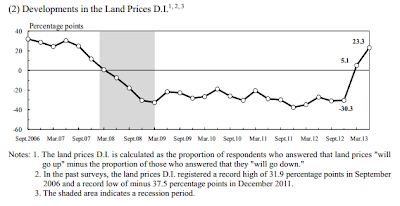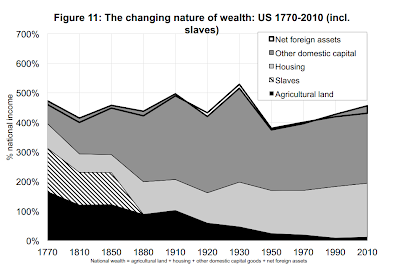Argentina's time is up. In February, the IMF
censured Argentina on account of its notoriously dubious inflation statistics. Under terms of the censure, Argentina was given until September 29, 2013, to improve the flawed data. The deadline has passed, and IMF Chief Christine Lagarde will report to the IMF Executive Board by November 13 on Argentina's progress (or, likely, lack thereof.)
Lagarde's impending report follows a long and nearly unbelievable saga (see timeline at the end of this post.) The gist of the matter is that officially-reported inflation has been
in the vicinity of 10% for the past few years, while a variety of
private estimates place the true value at 25% or higher. Oh, and the independent economists who publish these private estimates are threatened with
criminal prosecution. This September, economist Orlando Ferreres published his estimate that June monthly inflation was 1.9%, compared to the official estimate of 0.8% (with compounding, that's a big difference) and
could face a two-year prison sentence. I searched for Ferreres' website on November 3, and it appears to have been hacked (see image below.) I could not find Ferreres' independent inflation estimates on his site; only official estimates appear.
Red flags were raised in earnest in 2007, when then-President
Néstor Kirchner dismissed several staff statisticians at
INDEC, the statistics institute that publishes the official consumer-price index (CPI) for Argentina. The government
takeover of INDEC included the demotion of Graciela Bevacqua, director of the inflation index, who had prepared the inflation data for six years. In 2005, Bevacqua estimated that inflation was over 12% and rising. Bevacqua says that Interior Commerce Secretary Guillermo Moreno
began pressuring her to underreport inflation data in May 2006. From then until her demotion, Moreno
harassed her unrelentlessly, challenging her data and methodology and demanding more "favorable" estimates. Bevacqua refused to comply, resulting in her demotion and eventual resignation from government.
The 2007 Presidential elections certainly contributed to the pressure for more "favorable" inflation data. With Kirchner's appointees in place at INDEC, end-of-year inflation "
fell" from 12.3% in 2005 to 9.8% in 2006 to 8.5% in 2007. Christina Fernandez de Kirchner, wife of Néstor Kirchner, was elected President. After the elections, the data manipulation had to continue, to cover the previous manipulation.
In Argentina, inflation statistics have political significance that extends even deeper than their economic significance, as is common in countries with a history of hyperinflation. In the 1970s, like several other Latin American countries, Argentina borrowed heavily to fund its industrialization efforts. A variety of factors combined to exacerbate a
debt crisis in the 1980s, which was accompanied by high
inflation in Argentina and neighboring countries. Argentina faced quadruple-digit inflation in 1989 and 1990, with a hyperinflationary peak in March 1990. The disastrous consequences of hyperinflation, including stagnation of growth and capital flight, prompted
structural reforms in the 1990s, under
direction of the IMF,
which restored inflation to low levels. For a time, Argentina was viewed as a
model of success.
The situation in Argentina took a
turn for the worse around the time of the Brazilian devaluation in 1999. A
protracted recession erased most of the decade's gains in poverty reduction. As the federal government deficit widened to 2.5% of GDP in 1999, the
IMF advised the De la Rúa administration to implement austerity measures. Distress escalated to full-scale crisis, climaxing with the
largest debt default in history in December 2001. Following the default, Argentina faced exclusion from international capital markets and 41% inflation in 2002.
Legal battles with a subset of the bondholders continue to this day.
With this history, it is not surprising that both inflation and IMF relations are sensitive issues for Argentina. Bevacqua
says that Secretary Moreno "said that if we didn’t aim for zero inflation, we were unpatriotic.” The irony is that the deceptive data, intended to improve appearances, fooled no one, and made the country look worse rather than better. Consumers in Argentina are well aware that inflation is several times the official rate. A
consumer survey run by Torcuato di Tella University has measured inflation expectations near 30% for several years.
MIT economist Alberto Cavallo published an
investigation into Argentina's official price index in the widely-read Journal of Monetary Economics in 2012. Here is the abstract:
Prices collected from online retailers can be used to construct daily price indexes that complement official statistics. This paper studies their ability to match official inflation estimates in five Latin American countries, with a focus on Argentina, where official statistics have been heavily criticized in recent years. The data were collected between October 2007 and March 2011 from the largest supermarket in each country. In Brazil, Chile, Colombia, and Venezuela, online price indexes approximate both the level and main dynamics of official inflation. By contrast, Argentina’s online inflation rate is nearly three times higher than the official estimate.
Cavallo suggests that "the way the data is being altered is far simpler than commonly assumed. INDEC is a large organization, with many employees involved with the data collection and construction of the price indexes. Instead of changing the prices at the item level, it is probably easier for the government to change the aggregate numbers, which are seen by just a handful of people at the end of the CPI calculation process."
He adds, in conclusion, that "There is no obvious reason for why the government continues to manipulate the official price indexes. Some economists point to lower interest payments for inflation-linked bonds, while others highlight the fact that, by using artificially low inflation estimates in the budget, the government can avoid distributing any excess tax income to the provinces. However, these short-term resources are negligible next to the negative effects and uncertainty the manipulation has introduced in the economy."
Regarding Argentina's inflation-linked bonds, doubts about data accuracy began to wipe away their market
in 2007. Argentina originally issued inflation-linked bonds in 1973, and the "linkers" came to play a large role in public debt management. Even as late as 2009, a third of Argentine debt was linked to inflation. But in September 2009, Argentina launched a new bond, the Bonar 2015, as part of a
debt swap that replaced much of the inflation-indexed paper.
The collapse of Argentina's inflation-indexed bond market, though destructive, pales in comparison to the harms that have been inflicted on workers and consumers. A government-imposed
price freeze implemented in February, and another in June, appear unsurprisingly ineffective. The mismatch between official data and generally perceived cost-of-living increases makes satisfactory
wage negotiations between trade unions and the Ministry of Labor impossible. Erosion of purchasing power is likely much worse in the informal sector, which accounts for an
estimated 40% of Argentine workers. In addition, strict capital controls fuel a large
currency black market.
Lagarde describes the IMF censure of Argentina as a "yellow card." When Lagarde makes her report to the IMF Executive Committee later this month, if the data is not suitable, she will give a "
red card." It is not clear how harmful any potential IMF sanctions could be. Argentina is already the only Group of 20 country that
refuses to allow the IMF to conduct an annual review of the economy known as the Article IV consultation, and may not be overly concerned with further deterioration of relations with the IMF. A likely, if unsatisfactory, outcome is some knuckle-rapping and maintenance of the status quo for all practical purposes. The IMF
could suspend Argentina's voting and related rights and begin the process of compulsory withdrawal from the fund. A top international priority should be the minimization of contagion to other emerging markets-- which should be possible, since the situation is sufficiently Argentina-specific. The way out of the mess in Argentina is difficult to foresee. The way into the mess is outlined in the timeline below.
Timeline
1970s: Argentina borrows heavily to fund industrialization efforts.
1973: Argentina issues inflation-indexed bonds.
1980s: Argentine inflation heats up in the midst of Latin American debt crisis.
March 1990: Argentina's hyperinflation reaches peak.
1990s: Argentina implements IMF-directed structural reforms.
1998-2002: Argentina suffers severe recession.
June 31, 2001: Argentina swaps $29.5 billion of debt and defers $7.8 billion in interest payments.
December 23, 2001: Argentina defaults on $100 billion in debt.
2007: Kirchner replaces several statisticians at INDEC with political appointees.
December 10, 2007: Christina Fernandez de Kirchner becomes President.
September 2, 2009: Argentina swaps 16.7 billion pesos ($4.34 billion) of inflation-linked bonds for newly-issued 2014 and 2015 bonds to extend maturities and reduce financing costs.
January 2010: Standoff between Central Bank President Martín Redrado and President Kirchner over use of central bank reserves to pay debt. Redrado is fired, then reinstated by courts.
January 30, 2010: Central Bank President Redrado resigns. Redrado accuses government of data manipulation.
February 1, 2012: IMF Executive Board gives Argentina 180 days to implement specific measures to address quality of inflation data.
September 17, 2012: IMF Executive Board determines Argentina has made insufficient progress in implementing remedial measures.
February 4, 2013: Argentina announces two-month price freeze.
September 29, 2013: Deadline for Argentina to address concerns with inflation and GDP data.
November 13, 2013: Deadline for Christine Lagarde's report to IMF Executive Board on Argentina's progress.


















